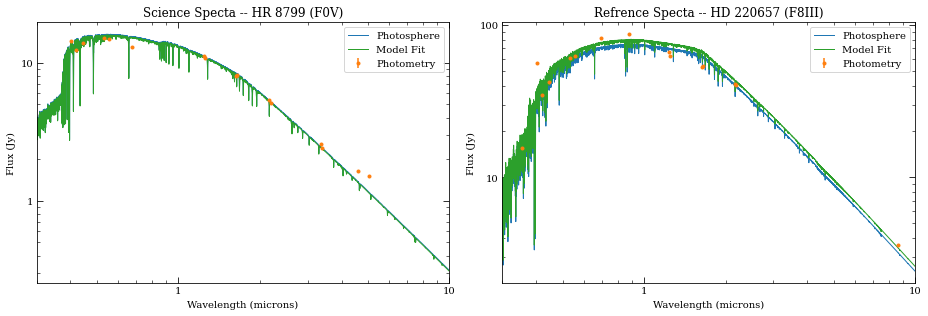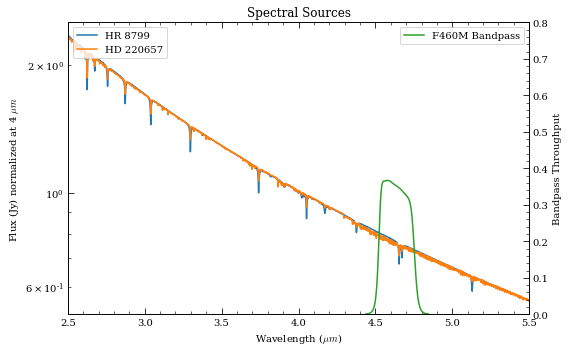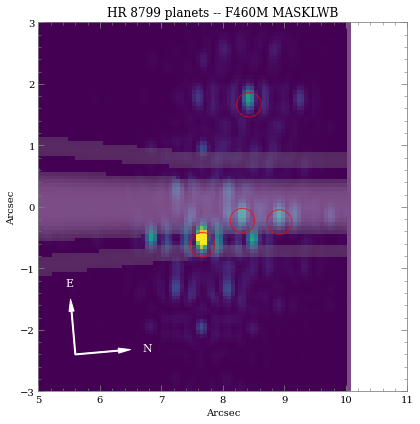Coronagraph Wedge Masks¶
The notebook builds on the concepts introduced in Coronagraph_Basics.ipynb. Specifically, we concentrate on the complexities involved in simulating the wedge coronagraphs.
[1]:
# Import the usual libraries
import numpy as np
import matplotlib
import matplotlib.pyplot as plt
# Enable inline plotting at lower left
%matplotlib inline
We will start by first importing pynrc along with the obs_hci (High Contrast Imaging) class, which lives in the pynrc.obs_nircam module.
[2]:
import pynrc
from pynrc import nrc_utils # Variety of useful functions and classes
from pynrc.obs_nircam import obs_hci # High-contrast imaging observation class
# Progress bar
from tqdm.auto import tqdm, trange
# Disable informational messages and only include warnings and higher
pynrc.setup_logging(level='WARN')
pyNRC log messages of level WARN and above will be shown.
pyNRC log outputs will be directed to the screen.
Source Definitions¶
In the previous notebook, we simply used the stellar_spectrum functions to create sources normalized at their observed K-Band magnitude. This time, we will utilize the source_spectrum class to generate a model fit to the known spectrophotometry. The user can find the relevant photometric data at http://vizier.u-strasbg.fr/vizier/sed/ and click download data as a VOTable.
[4]:
# Define 2MASS Ks bandpass and source information
bp_k = pynrc.bp_2mass('k')
# Science source, dist, age, sptype, Teff, [Fe/H], log_g, mag, band
args_sources = [('HR 8799', 39.0, 30, 'F0V', 7430, -0.47, 4.35, 5.24, bp_k)]
# References source, sptype, Teff, [Fe/H], log_g, mag, band
ref_sources = [('HD 220657', 'F8III', 5888, -0.01, 3.22, 3.04, bp_k)]
# Directory housing VOTables
# http://vizier.u-strasbg.fr/vizier/sed/
votdir = 'votables/'
[5]:
# Fit spectrum to SED photometry
i=0
name_sci, dist_sci, age, spt_sci, Teff_sci, feh_sci, logg_sci, mag_sci, bp_sci = args_sources[i]
vot = votdir + name_sci.replace(' ' ,'') + '.vot'
args = (name_sci, spt_sci, mag_sci, bp_sci, vot)
kwargs = {'Teff':Teff_sci, 'metallicity':feh_sci, 'log_g':logg_sci}
src = nrc_utils.source_spectrum(*args, **kwargs)
src.fit_SED(use_err=False, robust=False, wlim=[1,5])
# Final source spectrum
sp_sci = src.sp_model
[0.98590364]
[6]:
# Do the same for the reference source
name_ref, spt_ref, Teff_ref, feh_ref, logg_ref, mag_ref, bp_ref = ref_sources[i]
vot = votdir + name_ref.replace(' ' ,'') + '.vot'
args = (name_ref, spt_ref, mag_ref, bp_ref, vot)
kwargs = {'Teff':Teff_ref, 'metallicity':feh_ref, 'log_g':logg_ref}
ref = nrc_utils.source_spectrum(*args, **kwargs)
ref.fit_SED(use_err=False, robust=False, wlim=[0.5,10])
# Final reference spectrum
sp_ref = ref.sp_model
[1.07580856]
[7]:
# Plot spectra
fig, axes = plt.subplots(1,2, figsize=(13,4.5))
src.plot_SED(xr=[0.3,10], ax=axes[0])
ref.plot_SED(xr=[0.3,10], ax=axes[1])
axes[0].set_title('Science Specta -- {} ({})'.format(src.name, spt_sci))
axes[1].set_title('Refrence Specta -- {} ({})'.format(ref.name, spt_ref))
fig.tight_layout()

[8]:
# Plot the two spectra
fig, ax = plt.subplots(1,1, figsize=(8,5))
xr = [2.5,5.5]
for sp in [sp_sci, sp_ref]:
w = sp.wave / 1e4
ind = (w>=xr[0]) & (w<=xr[1])
sp.convert('Jy')
f = sp.flux / np.interp(4.0, w, sp.flux)
ax.semilogy(w[ind], f[ind], lw=1.5, label=sp.name)
ax.set_ylabel('Flux (Jy) normalized at 4 $\mu m$')
sp.convert('flam')
ax.set_xlim(xr)
ax.set_xlabel(r'Wavelength ($\mu m$)')
ax.set_title('Spectral Sources')
# Overplot Filter Bandpass
bp = pynrc.read_filter('F460M', 'WEDGELYOT', 'MASKLWB')
ax2 = ax.twinx()
ax2.plot(bp.wave/1e4, bp.throughput, color='C2', label=bp.name+' Bandpass')
ax2.set_ylim([0,0.8])
ax2.set_xlim(xr)
ax2.set_ylabel('Bandpass Throughput')
ax.legend(loc='upper left')
ax2.legend(loc='upper right')
fig.tight_layout()

Initialize Observation¶
Now we will initialize the high-contrast imaging class pynrc.obs_hci using the spectral objects and various other settings. The obs_hci object is a subclass of the more generalized NIRCam class. It implements new settings and functions specific to high-contrast imaging observations for corongraphy and direct imaging.
For this tutorial, we want to observe these targets using the MASKLWB coronagraph in the F460M filter. All wedge coronagraphic masks such as the MASKLWB (B=bar) should be paired with the WEDGELYOT pupil element. Observations in the LW channel are most commonly observed in WINDOW mode with a 320x320 detector subarray size. Full detector sizes are also available.
The wedge coronagraphs have an additional option to specify the location along the wedge to place your point source via the bar_offset keyword. If not specified, the location is automatically chosen based on the filter. A positive value will move the source to the right when viewing in ‘sci’ coordinate convention. Specifying this location is a non-standard mode.
In this case, we’re going to place our PSF at the narrow end of the LW bar, located at bar_offset=8 arcsec from the bar center.
[9]:
filt, mask, pupil = ('F460M', 'MASKLWB', 'WEDGELYOT')
wind_mode, subsize = ('WINDOW', 320)
fov_pix, oversample = (321, 2)
obs = pynrc.obs_hci(sp_sci, dist_sci, sp_ref=sp_ref, bar_offset=8, use_ap_info=False,
filter=filt, image_mask=mask, pupil_mask=pupil,
wind_mode=wind_mode, xpix=subsize, ypix=subsize,
fov_pix=fov_pix, oversample=oversample, large_grid=True)
Just as a reminder, information for the reference observation is stored in the attribute obs.Detector_ref, which is simply it’s own isolated DetectorOps class. The bar_offset value is initialized to be the same as the science observation.
Exposure Settings¶
Optimization of exposure settings are demonstrated in another tutorial, so we will not repeat that process here. We can assume that process was performed elsewhere to choose the BRIGHT2 pattern with 10 groups and 40 total integrations. These settings apply to each roll position of the science observation as well as the for the reference observation.
[10]:
# Update both the science and reference observations
# These numbers come from GTO Proposal 1194
obs.update_detectors(read_mode='BRIGHT2', ngroup=10, nint=40, verbose=True)
obs.gen_ref_det(read_mode='BRIGHT2', ngroup=4, nint=90)
New Ramp Settings
read_mode : BRIGHT2
nf : 2
nd2 : 0
ngroup : 10
nint : 40
New Detector Settings
wind_mode : WINDOW
xpix : 320
ypix : 320
x0 : 275
y0 : 1522
New Ramp Times
t_group : 2.138
t_frame : 1.069
t_int : 21.381
t_int_tot1 : 22.470
t_int_tot2 : 22.470
t_exp : 855.232
t_acq : 898.790
Add Planets¶
There are four known giant planets orbiting HR 8799. Ideally, we would like to position them at their predicted locations on the anticipated observation date. For this case, we choose a plausible observation date of November 1, 2022. To convert between \((x,y)\) and \((r,\theta)\), use the nrc_utils.xy_to_rtheta and nrc_utils.rtheta_to_xy functions.
When adding the planets, it doesn’t matter too much which exoplanet model spectrum we decide to use since the spectra are still fairly unconstrained at these wavelengths. We do know roughly the planets’ luminosities, so we can simply choose some reasonable model and renormalize it to the appropriate filter brightness.
Their are a few exoplanet models available to pynrc (SB12, BEX, COND). Let’s choose those from Spiegel & Burrows (2012).
[11]:
# Projected locations for date 11/01/2022
# These are prelimary positions, but within constrained orbital parameters
loc_list = [(-1.625, 0.564), (0.319, 0.886), (0.588, -0.384), (0.249, 0.294)]
# Estimated magnitudes within F444W filter
pmags = [16.0, 15.0, 14.6, 14.7]
[12]:
# Add planet information to observation class.
# These are stored in obs.planets.
# Can be cleared using obs.delete_planets().
obs.delete_planets()
for i, loc in enumerate(loc_list):
obs.add_planet(model='SB12', mass=10, entropy=13, age=age, xy=loc, runits='arcsec',
renorm_args=(pmags[i], 'vegamag', obs.bandpass))
[13]:
# Generate and plot a noiseless slope image to verify orientation
PA1 = 85 # Telescope V3 PA
PA_offset = -1*PA1 # Image field is rotated opposite direction
im_planets = obs.gen_planets_image(PA_offset=PA_offset, return_oversample=False)
[14]:
from matplotlib.patches import Circle
from pynrc.nrc_utils import plotAxes
from pynrc.obs_nircam import get_cen_offsets
fig, ax = plt.subplots(figsize=(6,6))
xasec = obs.det_info['xpix'] * obs.pixelscale
yasec = obs.det_info['ypix'] * obs.pixelscale
extent = [-xasec/2, xasec/2, -yasec/2, yasec/2]
xylim = 3
vmin = 0
vmax = 0.5*im_planets.max()
ax.imshow(im_planets, extent=extent, vmin=vmin, vmax=vmax)
# Overlay the coronagraphic mask
detid = obs.Detector.detid
im_mask = obs.mask_images['DETSAMP']
# Do some masked transparency overlays
masked = np.ma.masked_where(im_mask>0.95*im_mask.max(), im_mask)
ax.imshow(1-masked, extent=extent, alpha=0.3, cmap='Greys_r', vmin=-0.5)
for loc in loc_list:
xc, yc = get_cen_offsets(obs, idl_offset=loc, PA_offset=PA_offset)
circle = Circle((xc,yc), radius=xylim/15., alpha=0.7, lw=1, edgecolor='red', facecolor='none')
ax.add_artist(circle)
xlim = ylim = np.array([-1,1])*xylim
xlim = xlim + obs.bar_offset
ax.set_xlim(xlim)
ax.set_ylim(ylim)
ax.set_xlabel('Arcsec')
ax.set_ylabel('Arcsec')
ax.set_title('{} planets -- {} {}'.format(sp_sci.name, obs.filter, obs.image_mask))
color = 'grey'
ax.tick_params(axis='both', color=color, which='both')
for k in ax.spines.keys():
ax.spines[k].set_color(color)
plotAxes(ax, width=1, headwidth=5, alength=0.15, angle=PA_offset,
position=(0.1,0.1), label1='E', label2='N')
fig.tight_layout()

As we can see, even with “perfect PSF subtraction” and no noise, it’s difficult to make out planet e. This is primarily due to its location relative to the occulting mask reducing throughput combined with confusion of bright diffraction spots from nearby sources.
Estimated Performance¶
Now we are ready to determine contrast performance and sensitivites as a function of distance from the star.
Roll-Subtracted Images¶
First, we will create a quick simulated roll-subtracted image using the in gen_roll_image method. For the selected observation date of 11/1/2019, APT shows a PA range of 84\(^{\circ}\) to 96\(^{\circ}\). So, we’ll assume Roll 1 has PA1=85, while Roll 2 has PA2=95. In this case, “roll subtraction” simply creates two science observations at two different parallactic angles and subtracts the same reference observation from each. The two results are then de-rotated to a common PA=0
and averaged.
There is also the option to create ADI images, where the other roll position becomes the reference star by setting no_ref=True.
Contrast Curves¶
Next, we will cycle through a few WFE drift values to get an idea of potential predicted sensitivity curves. The calc_contrast method returns a tuple of three arrays: 1. The radius in arcsec. 2. The n-sigma contrast. 3. The n-sigma magnitude sensitivity limit (vega mag).
[15]:
# Cycle through a few WFE drift values
wfe_list = [0,5,10]
# PA values for each roll
PA1, PA2 = (85,95)
# A dictionary of HDULists
hdul_dict = {}
for wfe_drift in tqdm(wfe_list):
# Assume drift between Roll1 and Roll2 is 2 nm WFE
wfe_roll_drift = 0 if wfe_drift<2 else 2
# Assume perfect pointing (ie., xyoff_*** = (0,0) )
# to approximate results of advanced post-processing
hdulist = obs.gen_roll_image(PA1=PA1, PA2=PA2,
wfe_ref_drift=wfe_drift, wfe_roll_drift=wfe_roll_drift,
xyoff_roll1=(0,0), xyoff_roll2=(0,0), xyoff_ref=(0,0))
hdul_dict[wfe_drift] = hdulist
[16]:
from pynrc.nb_funcs import plot_hdulist
from matplotlib.patches import Circle
fig, axes = plt.subplots(1,3, figsize=(14,4.3))
xylim = 2.5
xlim = ylim = np.array([-1,1])*xylim
for j, wfe_drift in enumerate(wfe_list):
ax = axes[j]
hdul = hdul_dict[wfe_drift]
plot_hdulist(hdul, xr=xlim, yr=ylim, ax=ax, vmin=0, vmax=2)
# Location of planet
for loc in loc_list:
circle = Circle(loc, radius=xylim/15., lw=1, edgecolor='red', facecolor='none')
ax.add_artist(circle)
ax.set_title('$\Delta$WFE = {:.0f} nm'.format(wfe_drift))
nrc_utils.plotAxes(ax, width=1, headwidth=5, alength=0.15, position=(0.9,0.1), label1='E', label2='N')
fig.suptitle('{} -- {} {}'.format(name_sci, obs.filter, obs.image_mask), fontsize=14)
fig.tight_layout()
fig.subplots_adjust(top=0.85)

[17]:
nsig = 5
roll_angle = np.abs(PA2 - PA1)
curves = []
for wfe_drift in tqdm(wfe_list):
# Assume drift between Roll1 and Roll2 is 2 nm WFE
wfe_roll_drift = 0 if wfe_drift<2 else 2
# Generate contrast curves
result = obs.calc_contrast(roll_angle=roll_angle, nsig=nsig,
wfe_ref_drift=wfe_drift, wfe_roll_drift=wfe_roll_drift,
xyoff_roll1=(0,0), xyoff_roll2=(0,0), xyoff_ref=(0,0))
curves.append(result)
[18]:
from pynrc.nb_funcs import plot_contrasts, plot_planet_patches, plot_contrasts_mjup, update_yscale
import matplotlib.patches as mpatches
# fig, ax = plt.subplots(figsize=(8,5))
fig, axes = plt.subplots(1,2, figsize=(14,4.5))
xr=[0,5]
yr=[24,8]
# 1a. Plot contrast curves and set x/y limits
ax = axes[0]
ax, ax2, ax3 = plot_contrasts(curves, nsig, wfe_list, obs=obs,
xr=xr, yr=yr, ax=ax, return_axes=True)
# 1b. Plot the locations of exoplanet companions
label = 'Companions ({})'.format(filt)
planet_dist = [np.sqrt(x**2+y**2) for x,y in loc_list]
ax.plot(planet_dist, pmags, marker='o', ls='None', label=label, color='k', zorder=10)
# 1c. Plot Spiegel & Burrows (2012) exoplanet fluxes (Hot Start)
plot_planet_patches(ax, obs, age=age, entropy=13, av_vals=None)
ax.legend(ncol=2)
# 2. Plot in terms of MJup using COND models
ax = axes[1]
ax1, ax2, ax3 = plot_contrasts_mjup(curves, nsig, wfe_list, obs=obs, age=age,
ax=ax, twin_ax=True, xr=xr, yr=None, return_axes=True)
yr = [0.03,100]
for xval in planet_dist:
ax.plot([xval,xval],yr, lw=1, ls='--', color='k', alpha=0.7)
update_yscale(ax1, 'log', ylim=yr)
yr_temp = np.array(ax1.get_ylim()) * 318.0
update_yscale(ax2, 'log', ylim=yr_temp)
ax.legend(loc='upper right', title='BEX ({:.0f} Myr)'.format(age))
fig.suptitle('{} ({} + {})'.format(name_sci, obs.filter, obs.image_mask), fontsize=16)
fig.tight_layout()
fig.subplots_adjust(top=0.85, bottom=0.1 , left=0.05, right=0.97)

The innermost Planet e is above the detection threshold as suggested by the simulated images.
[ ]: